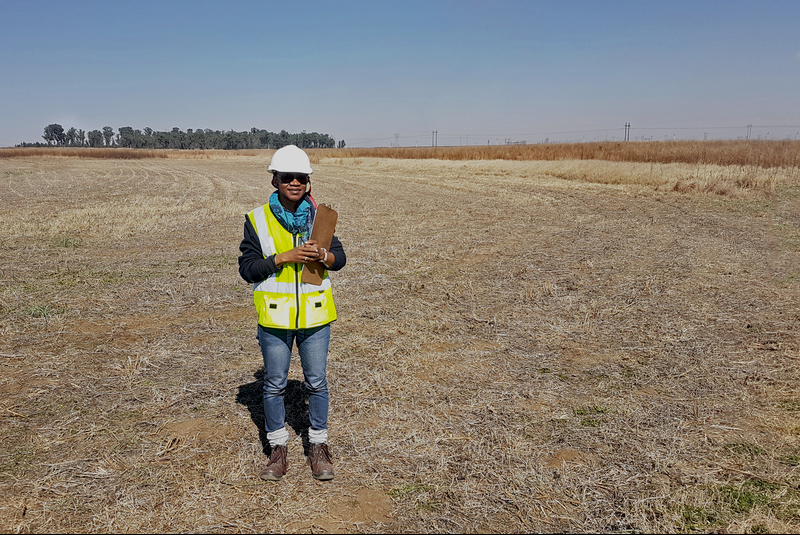Restoring land productivity
04 September 2017 | Story Kate-Lyn Moore. Photos Supplied.
Many people argue that the mining industry cannot be sustainable, says master’s student Nontobeko Gule.
“I think this is probably because once you start mining a mineral resource you deplete it and cannot replenish it,” she says. But “sustainable mining” doesn’t have to be an oxymoron.
A mining industry that is sustainable would not leave behind environmental and societal scars. It would also pay heed to the economic growth the industry can stimulate, Gule posits.
Gule is currently working towards her MPhil in sustainable mineral resource development. She is one of a number of African Development Bank-funded students completing the programme.
“A sustainable mining industry is one that is accountable to host communities and practises economic, social, environmental stewardship.”
“[Sustainable mining] focuses on minimising environmental degradation as a result of mining activity; as well as building relationships with host communities and ensuring that it empowers communities so that they can live sustainably even after a mine closes down.
“A sustainable mining industry is one that is accountable to host communities and practises economic, social, environmental stewardship,” she says.
Bitten by the mining bug
Gule has been fascinated with the mining industry since she was in high school when she visited the mine where her cousin worked as an engineer.
“The mining bug bit me,” she says.
After graduating with her honours in geochemistry from UCT in 2010, Gule began her working life as a geologist in the coal-mining industry. After one year in the position, she found herself with a host of questions about the sustainability of the industry.
The sector has come under intense scrutiny in recent years. This is due, in part, to mining practices that have an adverse effect on the environment and on surrounding communities, explains Gule.
“I therefore had an interest in how the mining industry could work on changing this negative image and contribute positively to society, whilst meeting its economic objectives. I was also very interested in how African people were benefiting from the mining of African mineral resources.”
Gule set out to gain a deeper understanding of the multifaceted factors that govern the industry in the hope that she would be able to contribute towards finding solutions to the social, environmental and economic challenges faced by society. Then she came across UCT’s MPhil specialising in sustainable mineral resource development.
“I knew that it could offer me the wide range of knowledge I need to steer my career in the mining sustainability industry,” she says.

Scarred landscapes
Gule is currently based in the town of Emalahleni (Witbank), which is predominantly a mining region. The landscape, bearing the scars of historical opencast coal mining, is the perfect place for Gule’s research.
“Opencast mining obliterates the landscape and compromises – and sometimes completely destroys – the land’s agricultural capability and biodiversity,” she says.
“It seems that in the past the aim was just to close the hole in the ground, without any concern of restoring the land’s productivity.”
When this land is not properly rehabilitated, the uses that the land can be put to are reduced, if not eliminated.
“Very evident traits of these landscapes are the perpetual soil erosion; sparse, uncontrolled plant growth; and overall unsightly degradation that would not support any sustainable usage of the land.”
Gule’s research aims to determine the uses that this typically poorly rehabilitated land can be put to. She will be investigating the level of rehabilitation carried out at sites in both Emalahleni and Middelburg.
“The proposed project hopes to contribute towards the alleviation of land degradation and the destruction of biodiverse ecosystems,” she says.
This will, in turn, contribute to the socio-economic well-being of surrounding communities.
Rehabilitation is mandatory
Historically, rehabilitation has been very poorly managed, says Gule. This is clear from even a cursory glance around Emalahleni where the land has not been restored to its previous state.
In South Africa, mining companies are required to submit a plan for mandatory rehabilitation before they begin mining. But these plans do not always take into account what the land was used for before mining, nor the degree to which it should be rehabilitated afterwards.
Often, the land is only partially restored and once-prolific farming land becomes barren and unworkable. Moreover, rehabilitation is left until the end of mining. This leads to issues such as acid mine drainage and erosion.
“It seems that in the past the aim was just to close the hole in the ground, without any concern of restoring the land’s productivity.”
In recent years, mining companies have put in an effort to restore land’s productivity, Gule says. More established companies, in particular, tend to carry out more sustainable rehabilitation. Importantly, rehabilitation is done concurrently with mining. As mining is finished in a portion of the mine, rehabilitation begins.
Research of this sort is indispensable, Gule maintains. Understanding what a sustainable mining industry could look like is an essential step towards alleviating the socio-economic and environmental challenges faced by both South African society and the world at large.
 This work is licensed under a Creative Commons Attribution-NoDerivatives 4.0 International License.
This work is licensed under a Creative Commons Attribution-NoDerivatives 4.0 International License.
Please view the republishing articles page for more information.
Research & innovation





































